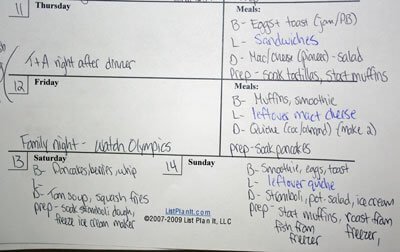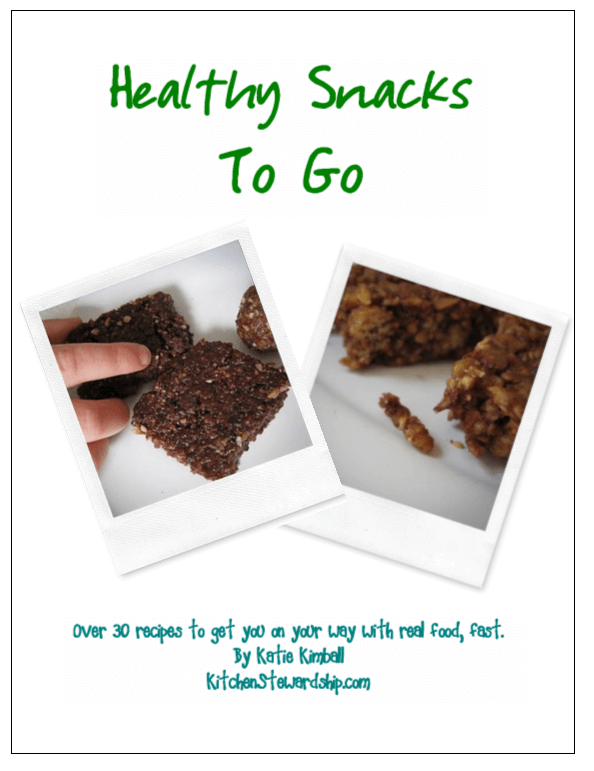Organization in the Real Food Kitchen: Planning to Make Food Preparation Happen
**Have you been enjoying this series on Organization in the Real Food Kitchen? Catch up on any posts that you may have missed in my Getting Organized category.**
 Image by shannahsin
Image by shannahsin
In the days before I began cooking real, traditional, whole foods, it wasn’t such a big deal if I forgot to think about dinner ahead of time. I could thaw some meat in the microwave, or use a can of something or other, or whip up a mix for cornmeal. Dinner still happened and no one was the wiser.
Now that I’ve tossed my microwave, soak all of my beans overnight before cooking, and serve only sourdough, soaked or sprouted grains, it’s not so easy. Yes, I can still figure something out in emergency situations. In general, though, my meal plan would grind to a screeching halt if I ceased to plan and take into account the food prep that needs to happen on a daily basis in my real food kitchen.
Over the years, I have realized that accomplishing these different food preparation tasks is really not difficult at all, but it requires three things of me:
1) Meal planning
If I don’t have a plan, bad things happen. I begin to go over my grocery budget. Food in my fridge gets wasted. We don’t eat as well as we should, relying on quick, convenience foods with an emphasis on too many grains. And most definitely, traditional methods of food preparation get tossed out the window (soaking, culturing, sprouting, fermenting, everything).
I’ve written extensively on meal planning. If that’s an area of struggle for you, here are some posts to help you out:
Organization in the Real Food Kitchen: Meal Planning
Organization in the Real Food Kitchen: Favorite Recipe Lists (what I use to help me meal plan efficiently)
Healthy Homemaking: Meal Planning Primer
2) Daily notes of what needs to be done
My current method for doing this is to make a note of what I need to do each day, underneath my list of meals. I keep this in my homemaking binder, on my weekly planning sheets. Here’s what it looks like:

The right hand side of my planner is where I list my meals, under B, L and D (breakfast, lunch, dinner). Below that, I write the word “prep”, and here I make a list of anything that needs to be done that day, to ensure that the planned meals can happen smoothly over the next day or two. This might include thawing meat, soaking dough, grinding grain, making lacto-fermented veggies, soaking beans, making kefir, and even freezing the ice cream maker canister.
It doesn’t matter what your list looks like, or where you record it. The point is to take a quick look at your meal plan, and then write down what needs to be done and when.
3) Set aside a time to do what’s on your list
This is the kicker. If you make a lovely meal plan and carefully write out the food prep that needs to be done, but you don’t look at your list, you’ll be back at square one. This only works if you actually review your list and take the time to do what it says.
I like to do this in the evenings, after I clean up from dinner. Often I do it while my husband gets the kids ready for bed, or perhaps just after they’ve gone down. If we have something we need to do immediately after dinner or we’re out for the evening, then I try to make a point of checking my list and taking 5 minutes in the kitchen before I get ready for bed.
Usually 5-10 minutes is all it takes. Run down to the freezer to grab an item or two (and why not pull out what you need for several days to save yourself another trip to the freezer?). Start some flour and cornmeal soaking to make cornbread. Whiz up some blender batter to make pancakes for breakfast. Toss a cup or two of dried beans into a pot and fill it up with water and a bit of apple cider vinegar.
The bonus? You’ve already started tomorrow’s meals and your cooking time will be cut down.




Stephanie, thanks for your tips. This is something that I really need to work on! I am in such a busy season right now and meal planning is definitely one of the things that has been put on the back burner for me. I’m looking forward to the day when I can really sit down and concentrate on making it a priority. Thanks for sharing what you have learned with others.
.-= Debbie´s last blog ..key west =-.
I am like you. As I do my menu planning I also plan what I need to for prep for the next day. Then I am steps ahead of the game when the next day comes.
Instead of doing a cup of beans at a time, I do a LOT and then freeze the extra cooked beans to use later. That way if I have forgotten something I still have beans ready to go with a little defrosting.
.-= Noelle´s last blog ..where does your food come from? =-.
@Noelle, I love to do the same things with my beans, especially for the days when I need them in smaller amounts. If I’m making something with a lot of beans, though (like a chili or big bean soup), I will still try to remember to soak them rather than relying on my frozen stash. It’s a great way to have beans ready to go, though!
My husband and I both work full time, and most of our lunches are leftover from the night before. To make mornings go more smoothly, when we’re cleaning up the kitchen the night before we immediately put individual portions into our lunch containers so our lunch is just “grab and go” the next day.
I’m also a big fan of double batches and freezing the extra.
.-= Kelli M´s last blog ..Hot Target Deal! =-.
I’m a big fan of my Living Cookbook program – it makes meal planning a breeze, prints grocery lists, and calculates nutrition info.
.-= Wendy (The Local Cook)´s last blog ..Fit Jerk Friday: Quinoa with Spinach =-.
You’ve inspired me to buy a whiteboard. Or maybe a chalkboard! 🙂
One of my biggest issues is that my husband’s work will often take him away unexpectedly in the evenings so I’m never quite sure who will be home (either to eat, and/or to help while I cook) for dinner. I work outside of the home all day, too, so that really shortens the amount of time I have in the kitchen. I guess the solution to that would be to make sure most everything I make can be frozen or saved as leftovers, I suppose….any suggestions?
@Molly, Although I can usually be home during the day, I think the most important prep things can be done anytime, like thawing and soaking things. It’s the actual cooking that is the biggest challenge when not home during the day! The two biggest things I can think of that would be helpful are the crock pot and pre-chopping. Since we try to eat a lot of veggies, I spend a lot of time chopping. If I can’t be home in time to do this, I chop all the veggies I’ll need and store them in bags or bowls in the fridge, then just dump them into whatever I’m cooking.
I do have a similar situation for quantity, since we have teens that may unexpectedly be gone and young adults that may unexpectedly pop over. Something new I’ve been doing which has worked really well is to make enough for everyone who might be here. Of course that generates a lot of leftovers, but instead of just putting out leftovers more than once a week, I’m trying to do creative planning with the leftovers into a new meal, such as leftover ham being used for a baked potato bar, and leftover rice from stir-fry becoming a Spanish rice side dish. Each week, the first two meals are planned this way, which is a wonderful budget booster also! Of course, if you make enough new dish for everyone, at some point the system can break down, but I’ve found more often that it all comes out really well.
I recently changed my weekly meal planning from scribbling it on a piece of scratch paper (that was very hard to read) to writing it out nicely/legibly on a pretty piece of stationary. I place it on the fridge & it does not make me have anxiety just looking at it. I also date it & plan on keeping them for this time next year to have ideas ready. Melissa
http://www.wingofam.blogspot.com
Great tips!
I have an “after supper routine” that includes a checklist of all the possibilities…soak beans, get out meat, etc along with sweep the floor, do dishes, etc. etc. and that really helps.
I am enjoying your blog so much. There is so much to learn! I am taking baby steps in the right direction (I think!!). Thanks for the time and energy you put into these posts!
.-= Michelle´s last blog ..Show Us Your Ministry Link up! =-.
Planning is key, isn’t it? I find the weeks I don’t plan we have scrambled eggs and toast for dinner. A lot. 😉
.-= Cara @ Health Home and Happiness´s last blog ..Review: The Omnivore’s Dilemma =-.
@Cara @ Health Home and Happiness, Ah yes, that’s a standard “mommy didn’t plan well enough” or “mommy’s all out of steam” dinner at our house too. Or grilled cheese with pickles. Another quick and easy favorite. Which we had for dinner tonight. Hmm… 🙂
I love this so much, I just had to link to this post in my last blog post! thanks for some great tips!
.-= alexis´s last blog ..Weekend Reading–Link Love! =-.
Wow! This is super helpful! I don’t go into it in nearly as much detail as you do, but I really appreciate your list and tips!! 🙂
.-= Rochelle´s last blog ..An Eventful Saturday =-.